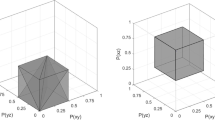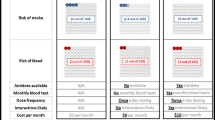Abstract
There is a growing body of evidence in the non-market valuation literature suggesting that responses to a sequence of discrete choice questions tend to violate the assumptions typically made by analysts regarding independence of responses and stability of preferences. Decision processes (or heuristics) such as value learning and strategic misrepresentation have been offered as explanations for these results. While a few studies have tested these heuristics as competing hypotheses, none has investigated the possibility that each explains the response behaviour of a subgroup of the population. In this paper, we make a contribution towards addressing this research gap by presenting a probabilistic decision process model designed to estimate the proportion of respondents employing defined heuristics. We demonstrate the model on binary and multinomial choice data sources and find three distinct types of response behaviour. The results suggest that accounting for heterogeneity in response behaviour may be a better way forward than attempting to identify a single heuristic to explain the behaviour of all respondents.
Similar content being viewed by others
References
Araña JE, León CJ, Hanemann MW (2008) Emotions and decision rules in discrete choice experiments for valuing health care programmes for the elderly. J Health Econ 27: 753–769
Ariely D, Loewenstein D, Prelec D (2003) ‘Coherent arbitrariness’: stable demand curves without stable preferences. Q J Econ 118(1): 73–105
Bateman IJ, Burgess D, Hutchinson WG, Matthews DI (2008a) Learning design contingent valuation: national oceanic and atmospheric administration guidelines, preference learning and coherent arbitrariness. J Environ Econ Manage 55: 127–141
Bateman IJ, Carson RT, Day B, Dupont D, Louviere JJ, Morimoto S, Scarpa R et al (2008b) Choice set awareness and ordering effects in discrete choice experiments. CSERGE working paper EDM 08-01
Beenstock M, Goldin E, Haitovsky Y (1998) Response bias in conjoint analysis of power outages. Energy Econ 20: 135–156
Bennett J, Blamey R (2001) The choice modeling approach to environmental valuation. Edward Elgar, Cheltenham
Boyle KJ, Bishop RC, Welsh MP (1985) Starting point bias in contingent valuation bidding games. Land Econ 61: 188–194
Bradley M, Daly A (1994) Use of the logit scaling approach to test for rank-order and fatigue effects in stated preference data. Transportation 21(2): 167–184
Braga J, Starmer C (2005) Preference anomolies, preference elicitation and the discovered preference hypothesis. Environ Resour Econ 32: 55–89
Cameron TA, Quiggin J (1994) Estimation using contingent valuation data from a “dichotomous choice with follow-up” questionnaire. J Environ Econ Manag 27: 218–234
Carlsson F, Martinsson P (2008a) Does it matter when a power outage occurs? A choice experiment study on the WTP to avoid power outages. Energy Econ 30(3): 1232–1245
Carlsson F, Martinsson P (2008b) How much is too much? An investigation of the effect of the number of choice sets, starting point and the choice of bid vectors in choice experiments. Environ Resour Econ 40(2): 165–176
Carson RT, Groves T (2007) Incentive and informational properties of preference questions. Environ Resour Econ 37: 181–210
Carson RT, Groves T, List J, Machina M (2004) Probabilistic influence and supplemental benefits: a field test of the two key assumptions behind using stated preferences. Paper presented at NBER Public Economics Workshop, Palo Alto
Carson KS, Chilton SM, Hutchinson WG (2009) Necessary conditions for demand revelation in double referenda. J Environ Econ Manag 57(2): 219–225
Caussade S, Ortuzar JD, Rizzi LI, Hensher DA (2005) Assessing the influence of design dimensions on stated choice experiment estimates. Trans Res Part B 39: 621–640
Day B, Pinto JL (2010) Ordering anomalies in choice experiments. J Environ Econ Manag 59(3): 271–285
Day B, Bateman IJ, Carson RT, Dupont D, Louviere JJ, Morimoto S, Scarpa R et al (2009) Task independence in stated preference studies: a test of order effect explanations. CSERGE working paper EDM 09–14
DeShazo JR (2002) Designing transactions without framing effects in iterative question formats. J Environ Econ Manag 43: 360–385
Hanemann WM, Loomis J, Kanninen B (1991) Statistical efficiency of double bounded dichotomous choice contingent valuation. Am J Agric Econ 73: 1255–1263
Hensher DA, Collins AT (2010) Interrogation of responses to stated choice experiments: is there sense in what respondents tell us?. J Choice Model 4: 62–89
Hensher DA, Greene WH (2010) Non-attendance and dual processing of common-metric attributes in choice analysis: a latent class specification. Empir Econ 39(2): 413–426
Hensher DA, Truong TP (1985) Valuation of travel time savings: a direct experimental approach. J Trans Econ Policy 19(3): 237–261
Herriges JA, Shogren JF (1996) Starting point bias in dichotomous choice valuation with follow-up questioning. J Environ Econ Manag 30: 112–131
Holmes T, Boyle KJ (2005) Dynamic learning and context-dependence in sequential, attribute-based stated-preference valuation questions. Land Econ 81: 114–126
Hurwicz L (1972) On informationally decentralized systems. In: McGuire CB, Radner R (eds) Decision and organisation.. University of Minnesota Press, North-Holland
Kahneman D, Tversky A (1979) Prospect theory: an analysis of decisions under risk. Econometrica 47: 263–291
Ladenburg J, Olsen SB (2008) Gender-specific starting point bias in choice experiments: evidence from an empirical study. J Environ Econ Manag 56: 275–285
Louviere JJ, Hensher DA (1983) Using discrete choice models with experimental design data to forecast consumer demand for a unique cultural event. J Consum Res 10(December): 348–361
McFadden D (1974) Conditional logit analysis of qualitative choice behaviour. In: Zarembka P (eds) Frontiers in econometrics. Academic Press, New York
McNair BJ, Bennett J, Hensher DA (2011a) A comparison of responses to single and repeated discrete choice questions. Resour Energy Econ 33: 554–571
McNair BJ, Bennett J, Hensher DA, Rose JM (2011b) Households’ willingness to pay for overhead-to-underground conversion of electricity distribution networks. Energy Policy 39: 2560–2567
Mirrlees J (1971) An exploration in the theory of optimal income taxation. Rev Econ Stud 38: 175–208
NERA Economic Consulting and ACNielsen (2003) Willingness to pay research study. A report for ACTEW Corporation and ActewAGL, September
Plott CR (1996) Rational individual behavior in markets and social choice processes: the discovered preference hypothesis. In: Arrow K, Colombatto E, Perleman M, Schmidt C (eds) Rational foundations of economic behavior. Macmillan, London
Samuelson PA (1954) The pure theory of public expenditure. Rev Econ Stat 36: 387–389
Scarpa R, Rose J (2008) Design efficiency for non-market valuation with choice modelling: how to measure it, what to report and why. Aust J Agric Resour Econ 52(3): 253–282
Scarpa R, Gilbride TJ, Campbell D, Hensher DA (2009) Modelling attribute non-attendance in choice experiments for rural landscape valuation. Eur Rev Agric Econ 36(2): 151–174
Zellman E, Kaye-Blake W, Abell W (2010) Identifying consumer decision-making strategies using alternative methods. Qual Market Res 13: 271–286
Author information
Authors and Affiliations
Corresponding author
Rights and permissions
About this article
Cite this article
McNair, B.J., Hensher, D.A. & Bennett, J. Modelling Heterogeneity in Response Behaviour Towards a Sequence of Discrete Choice Questions: A Probabilistic Decision Process Model. Environ Resource Econ 51, 599–616 (2012). https://doi.org/10.1007/s10640-011-9514-6
Accepted:
Published:
Issue Date:
DOI: https://doi.org/10.1007/s10640-011-9514-6




